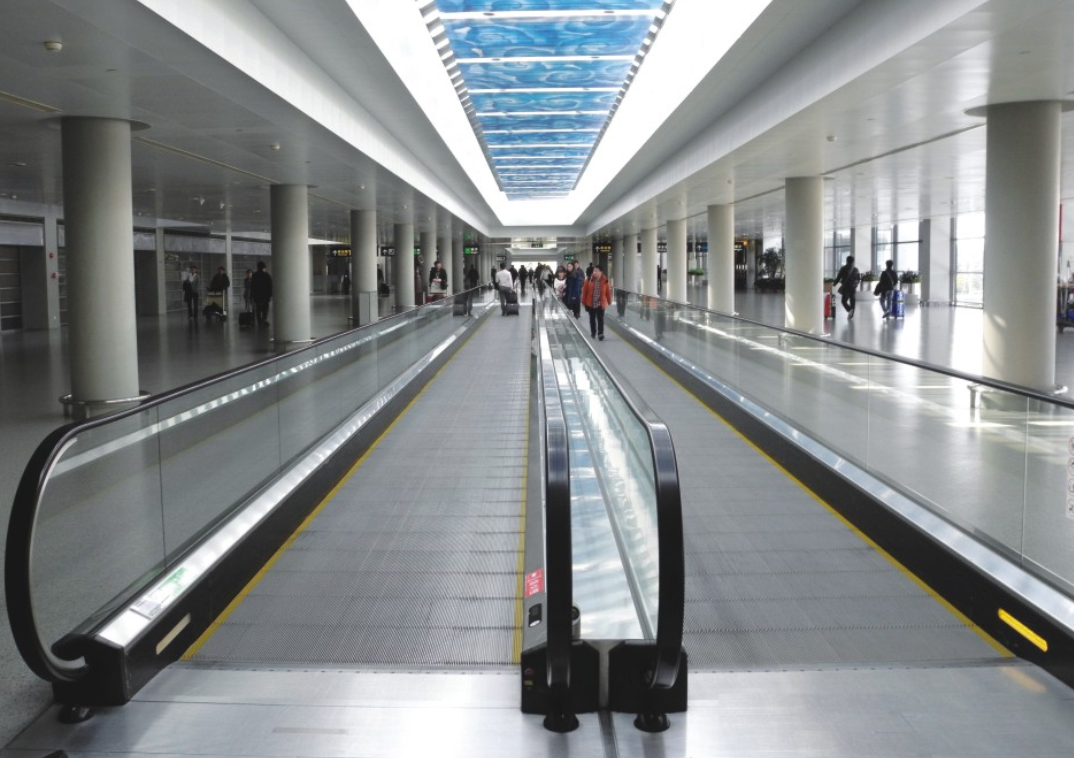1. What Is a Moving Walkway?
A moving walkway, also known as a travelator, moving sidewalk, or horizontal escalator, is a slow-moving conveyor mechanism that transports people horizontally or on an incline across short or long distances. It is commonly used in airports, metro stations, exhibition centers, and shopping malls to ease pedestrian flow and reduce fatigue.
Unlike escalators that move people vertically, moving walkways are designed for horizontal or slightly inclined movement. They consist of a continuous belt or pallet chain powered by motors and supported by a robust truss structure. This system enhances convenience in high-traffic areas and improves accessibility for passengers with luggage, strollers, or mobility aids.
2. Main Types of Moving Walkways
Moving walkways are categorized based on their surface design and inclination. Each type serves a specific purpose depending on the environment and intended traffic capacity.
2.1 Pallet Type Moving Walkway
The pallet type uses a series of metal or aluminum pallets forming a continuous walkway surface. These are typically used in airports and large transportation hubs where durability and stability are crucial. The pallets interlock seamlessly to create a smooth platform for passengers, luggage carts, and trolleys.
2.2 Belt Type Moving Walkway
Belt-type walkways use a continuous rubber or synthetic belt surface supported by rollers. These systems are lighter and quieter than pallet types, making them suitable for shopping malls and exhibition halls. They can be installed in both flat and inclined configurations.
2.3 Inclined Moving Walkway
Inclined moving walkways are designed for gentle slopes, usually not exceeding 12 degrees. They provide smooth transitions between floors in supermarkets or car parks, allowing users to move shopping carts easily without losing control.
3. Structural Components and Working Mechanism
The design of a moving walkway combines mechanical precision, electrical systems, and safety mechanisms to ensure smooth, continuous operation. Below is a breakdown of its major components and their functions.
| Component | Description | Function |
| Drive System | Electric motor and gear assembly | Powers the movement of the belt or pallets |
| Truss Frame | Steel support structure | Holds all mechanical and electrical components securely |
| Handrail | Rubber or PVC loop synchronized with walkway speed | Provides stability for passengers during movement |
| Comb Plate | Located at entry and exit points | Ensures a smooth transition between stationary and moving surfaces |
The working principle involves an electric motor driving a chain system connected to rollers or pallets. The motion is guided by a truss and supported by rollers beneath the walkway surface. Handrails move synchronously to provide balance and comfort. The system operates continuously at a speed typically between 0.5 to 0.75 meters per second.
4. Advantages of Using Moving Walkways
Moving walkways offer multiple benefits that enhance convenience, safety, and efficiency in large facilities. Their design supports both pedestrian comfort and crowd management.
- Improves pedestrian traffic flow in busy environments.
- Reduces walking fatigue, especially for travelers with luggage or mobility challenges.
- Enhances accessibility by providing a continuous, barrier-free pathway.
- Supports efficient circulation in airports, metros, and commercial complexes.
- Can be customized for different lengths, slopes, and load capacities.
- Requires minimal manual intervention once installed and calibrated.
5. Installation and Safety Considerations
Installation and maintenance of moving walkways must adhere to international safety standards to prevent accidents and ensure smooth operation. The design must accommodate passenger load, space constraints, and emergency systems.
5.1 Site Preparation and Structural Support
Before installation, the site should be properly prepared with stable foundations capable of supporting the truss and load capacity. The floor area must allow for the entry and exit zones, including sufficient clearance for passengers and carts.
5.2 Safety Features
Modern moving walkways include a range of safety features to protect users and operators. These include:
- Emergency stop buttons located at both ends of the walkway.
- Speed monitoring sensors to prevent overspeed conditions.
- Automatic lubrication systems for chain and bearing maintenance.
- Comb lighting and signage for visibility in low-light environments.
- Skirt brushes and deflectors to avoid trapping of clothing or objects.
5.3 Compliance Standards
Moving walkways must comply with standards such as EN 115 (Europe) or ASME A17.1 (USA), which specify requirements for design, installation, and maintenance. Regular inspections are mandatory to verify alignment, lubrication, and brake systems.
6. Applications of Moving Walkways
Moving walkways are versatile and adaptable to various environments. Their ability to move large numbers of people efficiently makes them indispensable in public and private spaces.
| Application Area | Purpose |
| Airports | Helps passengers move quickly between terminals and gates |
| Shopping Centers | Facilitates movement between floors with shopping carts |
| Metro Stations | Improves pedestrian circulation and reduces congestion |
| Exhibition Halls | Assists visitors in navigating large display areas efficiently |
7. Maintenance and Operational Efficiency
Regular maintenance ensures that a moving walkway remains reliable and safe for daily operation. Maintenance schedules typically involve inspection, cleaning, lubrication, and performance testing.
- Inspect chains, handrails, and bearings for wear or misalignment.
- Clean debris from comb plates and under the pallets.
- Verify that sensors and emergency stop buttons function correctly.
- Lubricate mechanical components to reduce friction and extend lifespan.
- Conduct operational tests to ensure smooth acceleration and deceleration.
8. Conclusion: The Role of Moving Walkways in Modern Infrastructure
Moving walkways have become an integral part of modern public infrastructure, enhancing mobility, efficiency, and convenience. Their mechanical design and adaptability allow for seamless integration into various environments, from airports to shopping centers. With proper installation, regular maintenance, and adherence to safety standards, moving walkways continue to be a cornerstone of efficient pedestrian transportation systems in the 21st century.












